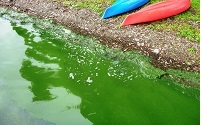MakingWaves - SepticSmart Week; CWSRF & DWSRF IUP; Coastal Resiliency Project; HABs Notifications
The New York State Department of Environmental Conservation sent this bulletin on 09/17/2021 11:00 AM EDT |
| DEC Delivers - Information to keep you connected and informed from the NYS Department of Environmental Conservation |
| Share or view as a web page || Update preferences or unsubscribe |
MakingWaves - News From the Division of Water |
In This issue:
SepticSmart WeekSeptember 20 - 24 is EPA's annual SepticSmart Week, which focuses on how to care for and maintain septic systems. Over one in five households in New York use septic systems. Proper use and maintenance of these systems protects the environment and our drinking water as well as saves homeowners from costly repairs. Homeowners should pump their septic tank at regular intervals as recommended by a professional and/or local permitting authority, and be careful about what goes down the drain or gets flushed. Fats and grease or disposable wipes can clog pipes and drainfield. DEC encourages homeowners with septic systems to learn how their systems work and how to care for them so that they stay in proper working condition. Find more information on EPA's website and on NYS Department of Health's website. Clean Water State Revolving Fund (CWSRF) for Water Pollution Control and Drinking Water State Revolving Fund (DWSRF) Draft Intended Use Plans (IUPs) for Federal Fiscal Year 2022Comments are being accepted until October 1 on the Draft Federal Fiscal Year 2022 Intended Use Plans (IUPs) for the CWSRF and the DWSRF. The CWSRF and DWSRF programs are available to municipalities and certain non-municipal entities in New York State to finance water quality and drinking water-related projects. The Draft IUPs include lists of projects that could receive financing between October 1, 2021 and September 30, 2022, the next IUP financing period. NYS Environmental Facilities Corporation (EFC) solicited new projects for the Draft 2022 IUPs in the May 12, 2021 State Register Notice and Environmental Notice Bulletin. New projects and project updates were accepted through July 16, 2021. Projects will not be added to the Final 2022 IUP lists by comment on the Draft IUP. NYS EFC and NYS Department of Health will host a webinar to review the Draft 2022 CWSRF and DWSRF IUPs on September 22 at 10:00 a.m. For more information about the webinar and how to comment, see the September 15 Environmental Notice Bulletin or visit EFC's website. Coastal Resiliency for South Shore of Staten IslandGovernor Kathy Hochul has announced the start of in-water construction of the Living Breakwaters, a $107 million effort that will provide physical, social, and ecological resiliency for the South Shore of Staten Island. The 2,400 linear feet of breakwaters, consisting of eight partially submerged enhanced stone and eco-concrete structures, will reduce the risks of storm waves and combat the long-term erosion of the beach along Conference House Park. Using extensive hydrodynamic wave modeling, the breakwaters were designed to reduce waves reaching onshore buildings and roads to below three feet in height, protecting the low-lying coastal community that experienced tragic loss of life when powerful waves knocked homes off their foundation during Superstorm Sandy. The project was designed to reverse the impacts of decades of erosion of the beach by capturing sediments along the shoreline, allowing the beach to widen over time. Harmful Algal Bloom (HAB) Notifications
Visit NYHABS, DEC’s harmful algal bloom notification map, to view locations of freshwater HABs in New York State that were reported in the past two weeks. Click on a dot for more information, including the date it was reported, the waterbody name, and pictures. Click on the arrow at the bottom of the screen to view a list of reported HABs. Know it. Avoid it. Report it. If you see a HAB, please use the reporting form to submit a report to NYHABS. Because waterbodies may have HABs that have not been reported to DEC, we recommend avoiding contact with floating mats, scums, and discolored water. If you, your family, or your pet have been in contact with a HAB, please rinse with clean water and report any symptoms to your local health department. Consider visiting a healthcare provider if you, your family, or your animals are experiencing symptoms related to blue-green harmful algal blooms. Symptoms include diarrhea, nausea, or vomiting; skin, eye, or throat irritation; and allergic reactions or breathing difficulties.
|

